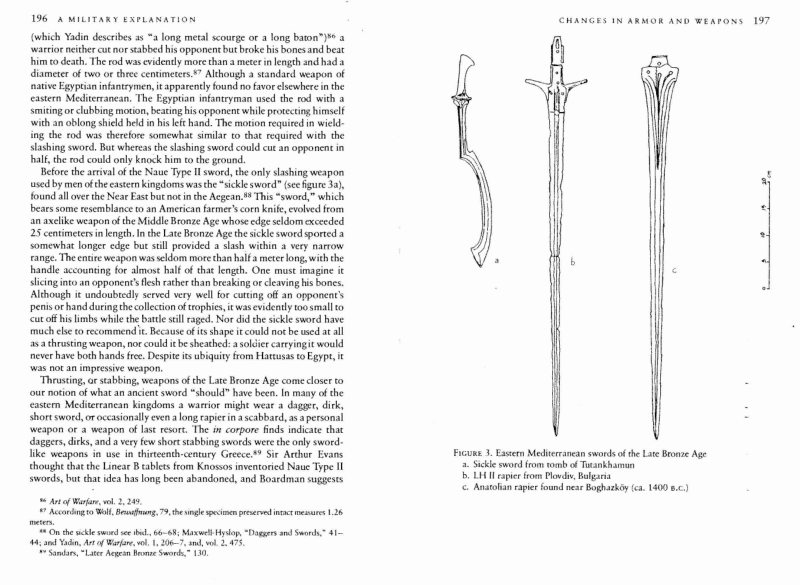Robert Drews makes reference to, and provides image of, a "sickle sword" in pre-exilic Egypt.
- Type
- Book
- Source
- Robert Drews Non-LDS
- Hearsay
- Secondary
- Reference
Robert Drews, The End of the Bronze Age: Changes in Warfare and the Catastrophe C.A. 1200 B.C. (Princeton: Princeton University Press, 1993), 196, 198
- Scribe/Publisher
- Princeton University Press
- People
- Robert Drews
- Audience
- Reading Public
- Transcription
Before the arrival of the Naue Type II sword, the only slashing weapon used by men of the eastern kingdoms was the “sickled sword” (see figure 3a), found all over the Near East but not in the Aegean. This “sword,” which bears some resemblance to an American farmer’s corn knife, evolved from an axelike weapon of the Middle Bronze Age whose edge seldom exceeded 25 centimeters in length. In the Late Bronze Age the sickle sword sported a somewhat longer edge but still provided a slash within a very narrow range. The entire weapon was seldom more than half a meter, with the handle accounting for almost half of that length. One must imagine it slicing into an opponent’s flesh rather than breaking or cleaving his bones. Although it undoubtedly served very well for cutting off an opponent’s penis or hand during the collection of trophies, it was evidently too small to cut off his limbs while the battle still raged. Nor did the sickle sword have much else to recommend it. Because of its shape it could not be used at all as a thrusting weapon, nor could it be sheathed: a soldier carrying it would never have both hands free. Despite its ubiquity from Hattusas to Egypt, it was not an impressive weapon . . . The traditional weapons of the eastern Mediterranean kingdoms continued in use until the twelfth century. A relief of Ramesses III on the north wall at Medinet Habu shows twenty native Egyptians, all hand-to-hand warriors, guarding a line of captives. Each Egyptian carries a spear in his right hand and another weapon in his left. Of the weapons in the left hand, six are dirks, six are rods, and seven are sickle swords. Not one of the Egyptian infantrymen carries a long sword.
- Citations in Mormonr Qnas
The B. H. Roberts Foundation is not owned by, operated by, or affiliated with the Church of Jesus Christ of Latter-day Saints.

